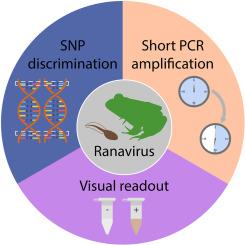两栖动物感染ranavirus的快速现场检疫检测
IF 6
2区 化学
Q1 CHEMISTRY, ANALYTICAL
引用次数: 0
摘要
ranavirus的爆发造成了大部分两栖动物的高死亡率,导致两栖动物灭绝和生态失衡。除了传统的ranavirus检测方法外,还介绍了一些等温方法,包括环介导的等温扩增和重组酶聚合酶扩增。然而,以前的技术面临着诸如冗长的分析和由于相似的基因序列而无法区分的病毒名称等缺点。因此,快速的现场鉴定是防止其致命传播的关键,聚合酶链反应(PCR)通常用于检测受感染物种。结果建立了一种基于等位基因特异性PCR (AS-PCR)的蛙病毒3 (FV3)和虎蛙病毒(TFV)两种ranavirus毒株的单核苷酸多态性(SNP)鉴定方法,用于快速的现场检疫。由于FV3和TFV的基因序列高度相似,通过设计一个共同的反向引物来实现检测,使得三个引物足以进行多重检测。反应用时不到40 min,特异性和灵敏度高,分别在101 bp和223 bp处鉴定出FV3和TFV,检出限约为1 ng/μL。此外,在促进dna的硝酸银溶液的紫外线照射下,银纳米颗粒形成的颜色变化证实了感染了FV3、TFV或两者的两栖动物的可见读数。意义本研究简要分析了一锅蛙感染中ranavirus毒株的特异性检测,这是以往很少报道的。因此,这种方法能够对受感染的两栖动物进行快速的现场检疫,广泛应用于边境口岸、野生动物保护区和农场的两栖动物贸易和保护。本文章由计算机程序翻译,如有差异,请以英文原文为准。


A fast on-site quarantine for the detection of amphibian infection of ranavirus
Background
The ranavirus outbreak has caused high mortality in mostly amphibian species, which has led to the amphibian extinction and ecological imbalance. Besides the conventional method for ranavirus detection, some isothermal methods, including loop-mediated isothermal amplification and recombinase polymerase amplification, have also been introduced. However, previous techniques face drawbacks such as lengthy analysis and indistinguishable viral names due to similar gene sequences. Therefore, fast on-site identification of ranavirus is crucial to prevent its deadly spread, and polymerase chain reaction (PCR) is typically used to detect infected species.
Result
This study developed a method to precisely discriminate two ranavirus strains – frog virus 3 (FV3) and tiger frog virus (TFV) – for fast on-site quarantine via single nucleotide polymorphism (SNP) discrimination using allele-specific PCR (AS-PCR). Due to high gene sequence similarity, detection was achieved by designing a common reverse primer for FV3 and TFV, making three primers sufficient for multiplex detection. The reaction took less than 40 min and showed high specificity and sensitivity, identifying FV3 at 101 bp and TFV at 223 bp with a detection limit of approximately 1 ng/μL of genetic material. Moreover, a visible readout for amphibians infected with FV3, TFV, or both was confirmed by a color change in silver nanoparticle formation under UV illumination from a DNA-promoting silver nitrate solution.
Significance
The research illustrates a short analysis for the specific detection of ranavirus strains among frog infections in one pot, which has rarely been described before. Hence, this approach enables rapid on-site quarantine of infected amphibians, with broad applications in amphibian trade and conservation at border gates, wildlife sanctuaries, and farms.
求助全文
通过发布文献求助,成功后即可免费获取论文全文。
去求助
来源期刊

Analytica Chimica Acta
化学-分析化学
CiteScore
10.40
自引率
6.50%
发文量
1081
审稿时长
38 days
期刊介绍:
Analytica Chimica Acta has an open access mirror journal Analytica Chimica Acta: X, sharing the same aims and scope, editorial team, submission system and rigorous peer review.
Analytica Chimica Acta provides a forum for the rapid publication of original research, and critical, comprehensive reviews dealing with all aspects of fundamental and applied modern analytical chemistry. The journal welcomes the submission of research papers which report studies concerning the development of new and significant analytical methodologies. In determining the suitability of submitted articles for publication, particular scrutiny will be placed on the degree of novelty and impact of the research and the extent to which it adds to the existing body of knowledge in analytical chemistry.
 求助内容:
求助内容: 应助结果提醒方式:
应助结果提醒方式:


